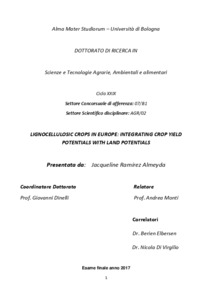Ramirez Almeyda, Jacqueline
(2017)
Lignocellulosic Crops in Europe: Integrating Crop Yield Potentials with Land Potentials, [Dissertation thesis], Alma Mater Studiorum Università di Bologna.
Dottorato di ricerca in
Scienze e tecnologie agrarie, ambientali e alimentari, 29 Ciclo. DOI 10.6092/unibo/amsdottorato/7854.
Documenti full-text disponibili:
![[img]](http://amsdottorato.unibo.it/7854/1.hassmallThumbnailVersion/Tesi_J.Ramirez_2017_Lignocellulosic%20crops%20potentials%20in%20EU.pdf)  Anteprima |
|
Documento PDF (English)
- Richiede un lettore di PDF come Xpdf o Adobe Acrobat Reader
Disponibile con Licenza: Salvo eventuali più ampie autorizzazioni dell'autore, la tesi può essere liberamente consultata e può essere effettuato il salvataggio e la stampa di una copia per fini strettamente personali di studio, di ricerca e di insegnamento, con espresso divieto di qualunque utilizzo direttamente o indirettamente commerciale. Ogni altro diritto sul materiale è riservato.
Download (8MB)
| Anteprima
|
Abstract
Given the ambitious EU targets to further decarbonise the economy, it can be expected that the demand for lignocellulosic biomass will continue to grow. Provisioning of part of this biomass by dedicated biomass crops becomes an option. This study presents integrated approach for crop allocation based on land availability and crop requirements. The model analysis to investigate the potential extension of unused land and its suitability for lignocellulosic crops was carried out in 37 European countries at the NUTS3 level. The CAPRI model predicts future land use changes and was used as a basic input to assess the agricultural biomass potentials in Europe. It was then identified the total land resource with a post-modeling assessment for three different potentials to the year 2020 and 2030, according to sustainability criteria formulated in the Renewable Energy directive (RED). Furthermore, crop-specific suitability maps were generated for each crop based on the variability of biophysical factors such as climate, soil properties and topographical aspects. The yields and cost levels that can be reached in Europe with different perennial crops in different climatic, soil and management situations. The AquaCrop model developed by FAO was used and fed with phenological parameters per crop and detailed weather data to simulate the crop growth in all European Nuts 3 regions. Yield levels were simulated for a maximum and a water-limited yield situation and further converted to match with low, medium and high input management systems. The costs production was assessed with an Activity Based Costing (ABC) model, developed to assess the roadside Net Present Value (NPV) cost of biomass. The yield, crop suitability and cost simulation results were then combined to identify the best performing crop-management mix per region.
Abstract
Given the ambitious EU targets to further decarbonise the economy, it can be expected that the demand for lignocellulosic biomass will continue to grow. Provisioning of part of this biomass by dedicated biomass crops becomes an option. This study presents integrated approach for crop allocation based on land availability and crop requirements. The model analysis to investigate the potential extension of unused land and its suitability for lignocellulosic crops was carried out in 37 European countries at the NUTS3 level. The CAPRI model predicts future land use changes and was used as a basic input to assess the agricultural biomass potentials in Europe. It was then identified the total land resource with a post-modeling assessment for three different potentials to the year 2020 and 2030, according to sustainability criteria formulated in the Renewable Energy directive (RED). Furthermore, crop-specific suitability maps were generated for each crop based on the variability of biophysical factors such as climate, soil properties and topographical aspects. The yields and cost levels that can be reached in Europe with different perennial crops in different climatic, soil and management situations. The AquaCrop model developed by FAO was used and fed with phenological parameters per crop and detailed weather data to simulate the crop growth in all European Nuts 3 regions. Yield levels were simulated for a maximum and a water-limited yield situation and further converted to match with low, medium and high input management systems. The costs production was assessed with an Activity Based Costing (ABC) model, developed to assess the roadside Net Present Value (NPV) cost of biomass. The yield, crop suitability and cost simulation results were then combined to identify the best performing crop-management mix per region.
Tipologia del documento
Tesi di dottorato
Autore
Ramirez Almeyda, Jacqueline
Supervisore
Co-supervisore
Dottorato di ricerca
Ciclo
29
Coordinatore
Settore disciplinare
Settore concorsuale
Parole chiave
Lignocellulosic crop, Biomass potentials, Unused lands, Released land, Land suitability, Economic Models
URN:NBN
DOI
10.6092/unibo/amsdottorato/7854
Data di discussione
23 Maggio 2017
URI
Altri metadati
Tipologia del documento
Tesi di dottorato
Autore
Ramirez Almeyda, Jacqueline
Supervisore
Co-supervisore
Dottorato di ricerca
Ciclo
29
Coordinatore
Settore disciplinare
Settore concorsuale
Parole chiave
Lignocellulosic crop, Biomass potentials, Unused lands, Released land, Land suitability, Economic Models
URN:NBN
DOI
10.6092/unibo/amsdottorato/7854
Data di discussione
23 Maggio 2017
URI
Statistica sui download
Gestione del documento:


 Login
Login
